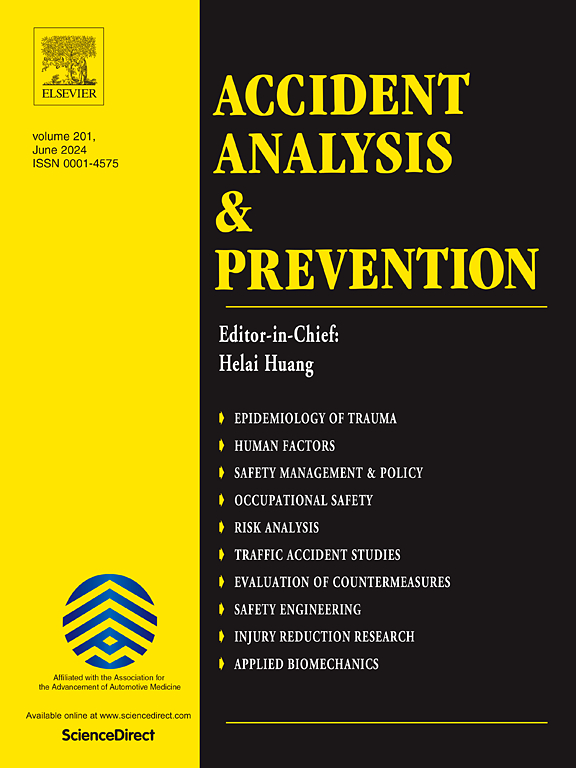城市工区建筑区域布局对道路安全的影响
IF 6.2
1区 工程技术
Q1 ERGONOMICS
引用次数: 0
摘要
尽管工作区配置对交通安全起着至关重要的作用,但从城市工作区内建筑面积布局的角度对工作区配置影响整体安全的理解有限。本研究通过考察施工区域布局对变道、经过施工区域的驾驶行为和驾驶稳定性的关键影响来解决这一空白。在本研究中,重型设备的位置反映了建筑区域的布局。通过驾驶模拟器实验,对26名被试(男14名、女12名)进行模拟真实城市工作区场景,评估建筑区域布局对安全的影响。该实验还考虑了两个与安全相关的关键独立变量:驾驶员性别和环境光照条件。为了评估驾驶员行为并识别安全关键模式,采用了参数生存模型、多变量方差分析(MANOVA)和回归分析。研究结果突出了施工区域的显著影响:(1)施工区域布局中,重型设备的位置更靠近工作区中心(位置2),使得驾驶员的归并距离增加了14.6%,突出了重型设备在工作区起始位置(位置1)的重要性,(2)位置2使得驾驶员能够以更高的速度通过工作区以通过施工区域。驾驶员性别和环境光照条件也会产生显著影响。例如,在夜间观察到纵向速度的增加,这表明需要提高能见度和速度控制。男性驾驶员比女性驾驶员更倾向于以更稳定的纵向速度通过施工区域。这些发现对于通过仔细考虑建筑区域布局设计、改善环境照明条件和针对特定人群的战略性安全干预措施来提高工作区安全具有重要意义。这些见解为提高城市工作区的安全和运营效率、降低事故风险、保护驾驶员和施工人员提供了宝贵的指导。本文章由计算机程序翻译,如有差异,请以英文原文为准。
Impact of the construction area layout on road safety in urban work zones
Despite the crucial role that work zone configurations play in traffic safety, there is a limited understanding of work zone configuration from the perspective of construction area layout within urban work zones impacts overall safety. This study addresses this gap by examining the critical influence of construction area layout on lane-changing, driving behavior passing by the construction area, and driving stability. Construction area layout was reflected by the position of heavy equipment in this study. A driving simulator experiment was conducted with 26 participants (14 males and 12 females) to simulate real-world urban work zone scenarios and assess the impact of construction area layout on safety. The experiment also considered two key safety-related independent variables: driver gender and ambient light condition. To evaluate driver behaviors and identify safety–critical patterns, parametric survival modeling, Multivariate analysis of variance (MANOVA), and regression analysis were employed. The findings highlight the significant impact of the construction area: (1) the construction area layout whereby heavy equipment was positioned closer to the center of the work zone (Position 2) prompted drivers’ merging distance to be 14.6% longer, underscoring the importance of heavy equipment at the start of the work zone (Position 1), and (2) Position 2 enables drivers to pass the work zone with a higher speed to pass by the construction area. The driver gender and ambient light condition can also have a significant effect. For example, the increased longitudinal velocity was observed during nighttime, suggesting a need for enhanced visibility and speed control. Male drivers tend to pass by the construction area with a more stable longitudinal velocity than female drivers. These findings are significant for improving work zone safety through careful consideration of construction area layout design, enhanced ambient lighting condition, and strategic safety interventions for specific groups. These insights offer valuable guidance for improving safety and operational efficiency in urban work zones, reducing the risk of accidents, and safeguarding both drivers and construction personnel.
求助全文
通过发布文献求助,成功后即可免费获取论文全文。
去求助
来源期刊

Accident; analysis and prevention
Multiple-
CiteScore
11.90
自引率
16.90%
发文量
264
审稿时长
48 days
期刊介绍:
Accident Analysis & Prevention provides wide coverage of the general areas relating to accidental injury and damage, including the pre-injury and immediate post-injury phases. Published papers deal with medical, legal, economic, educational, behavioral, theoretical or empirical aspects of transportation accidents, as well as with accidents at other sites. Selected topics within the scope of the Journal may include: studies of human, environmental and vehicular factors influencing the occurrence, type and severity of accidents and injury; the design, implementation and evaluation of countermeasures; biomechanics of impact and human tolerance limits to injury; modelling and statistical analysis of accident data; policy, planning and decision-making in safety.
 求助内容:
求助内容: 应助结果提醒方式:
应助结果提醒方式:


